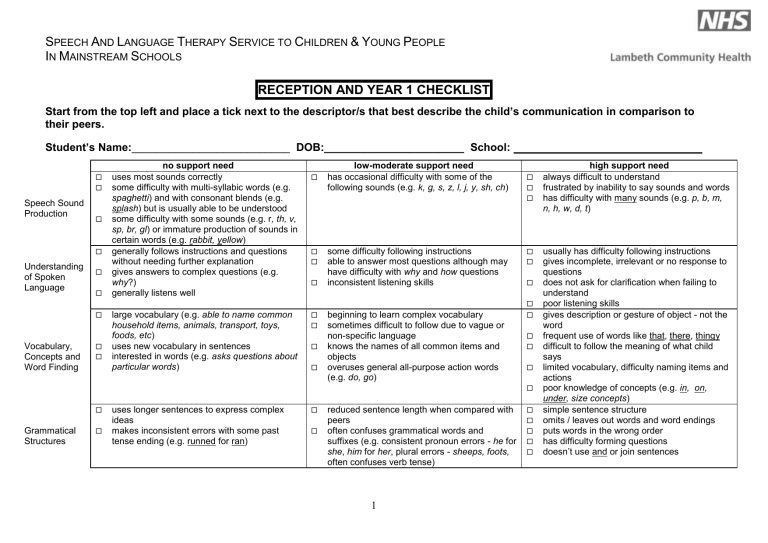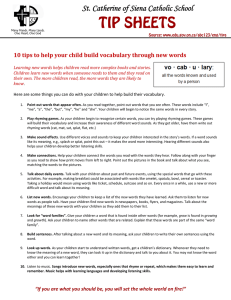Checklist year R and 1 (updated) (nbarrett v1)
advertisement

SPEECH AND LANGUAGE THERAPY SERVICE TO CHILDREN & YOUNG PEOPLE IN MAINSTREAM SCHOOLS RECEPTION AND YEAR 1 CHECKLIST Start from the top left and place a tick next to the descriptor/s that best describe the child’s communication in comparison to their peers. Student’s Name:__________________________ DOB:_______________________ School: Speech Sound Production Understanding of Spoken Language no support need uses most sounds correctly some difficulty with multi-syllabic words (e.g. spaghetti) and with consonant blends (e.g. splash) but is usually able to be understood some difficulty with some sounds (e.g. r, th, v, sp, br, gl) or immature production of sounds in certain words (e.g. rabbit, yellow) generally follows instructions and questions without needing further explanation gives answers to complex questions (e.g. why?) generally listens well low-moderate support need has occasional difficulty with some of the following sounds (e.g. k, g, s, z, l, j, y, sh, ch) some difficulty following instructions able to answer most questions although may have difficulty with why and how questions inconsistent listening skills Vocabulary, Concepts and Word Finding large vocabulary (e.g. able to name common household items, animals, transport, toys, foods, etc) uses new vocabulary in sentences interested in words (e.g. asks questions about particular words) beginning to learn complex vocabulary sometimes difficult to follow due to vague or non-specific language knows the names of all common items and objects overuses general all-purpose action words (e.g. do, go) Grammatical Structures uses longer sentences to express complex ideas makes inconsistent errors with some past tense ending (e.g. runned for ran) reduced sentence length when compared with peers often confuses grammatical words and suffixes (e.g. consistent pronoun errors - he for she, him for her, plural errors - sheeps, foots, often confuses verb tense) 1 high support need always difficult to understand frustrated by inability to say sounds and words has difficulty with many sounds (e.g. p, b, m, n, h, w, d, t) usually has difficulty following instructions gives incomplete, irrelevant or no response to questions does not ask for clarification when failing to understand poor listening skills gives description or gesture of object - not the word frequent use of words like that, there, thingy difficult to follow the meaning of what child says limited vocabulary, difficulty naming items and actions poor knowledge of concepts (e.g. in, on, under, size concepts) simple sentence structure omits / leaves out words and word endings puts words in the wrong order has difficulty forming questions doesn’t use and or join sentences Narrative Social Communication Phonological Awareness Fluency / Stuttering Voice Mother Tongue Assessment no support need participates in shared book sessions tells stories with a range of connecting words (e.g. and then, because, when) includes details (e.g. descriptive language and direct speech) interested in a range of topics needs occasional prompts to hold a conversation generally stays on topic talks about important events and includes lots of details asks questions and responds appropriately to questions takes turns in conversations able to recognise rhyming words able to generate words beginning with a sound consistently interprets some culturally familiar written and visual symbols (e.g. McDonalds) aware of concepts (e.g. sounds, letters, words) low-moderate support need able to tell you about recent events or retell a simple familiar story using simple sentences with very little detail included. poor sequencing of the events in a story only connects sentences with and needs some help to hold a conversation and stay on topic speaks but gives limited information problems verbally interacting with their peers (e.g. negotiating, changing roles) some difficulty in recognising rhyming words able to give some examples of sounds and letters some awareness of concepts (e.g. sounds, letters, words) high support need unable to tell you about recent events unable to retell a simple familiar story labels each picture, doesn’t tell a story doesn’t use and, then, because in stories needs a lot of help to hold a conversation talks about irrelevant or limited topics unable to maintain a topic rarely speaks doesn’t use “classroom talking rules” shows little awareness of listener needs individual support to complete tasks unable to recognise rhyming words by listening unable to give examples of sounds and letters possesses little awareness of print conventions possesses no awareness of concepts (e.g. sounds, letters, words) speaks fluently sound and word repetitions heard when the frequently repeats sounds or words child is excited, tired or nervous physically struggles to get words out often uses ums and ers to get started becomes frustrated due to stammering If the child has an unusual quality of voice e.g. hoarse, nasal or monotonous which persists for more than 3 weeks, please refer to the GP. □ no difficulties in home language or English □ language skills in home language are as □ language skills in both home language and expected, some difficulties in English – please English well below expected level, errors contact EMA support evident in both languages Who is able to work with this child regularly on a speech/language program? (e.g. teacher, LSA, SENCO, parent, grandparent) What additional support/ strategies have been/ are being used with this child? Were they effective? What are the outcomes you want from speech and language therapy support? How will you know when these have been met? Class Teacher Signature: ________________________________Name: 2 Date:






